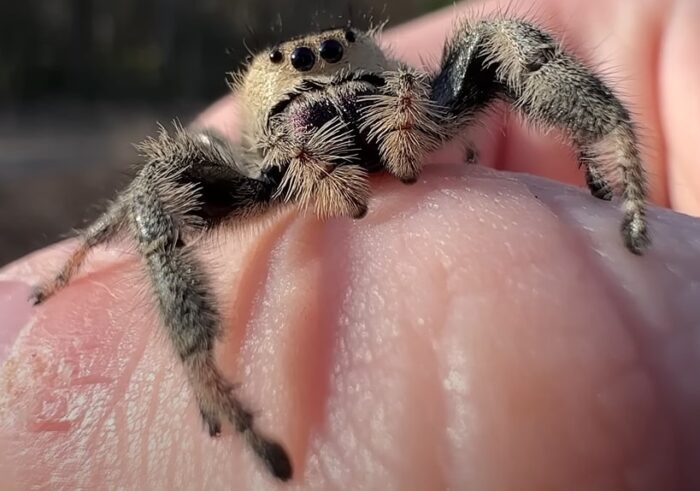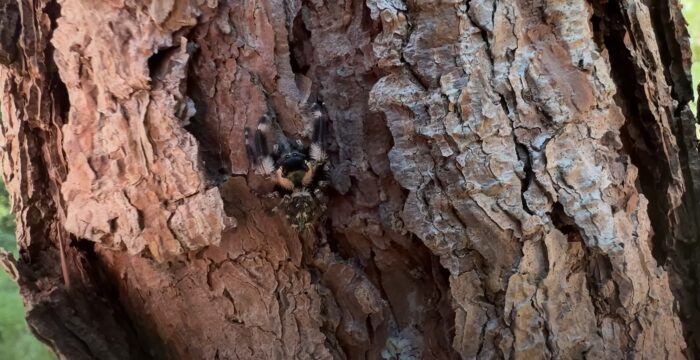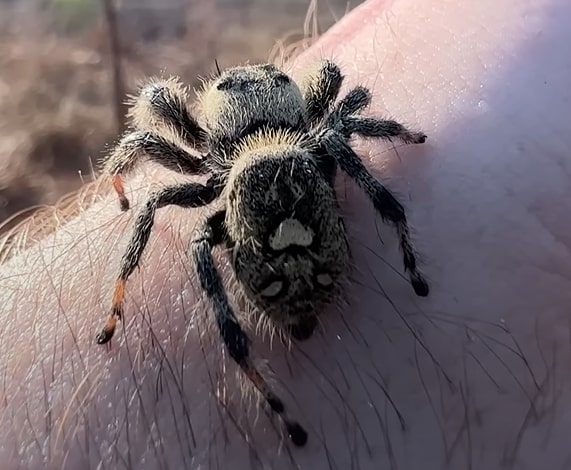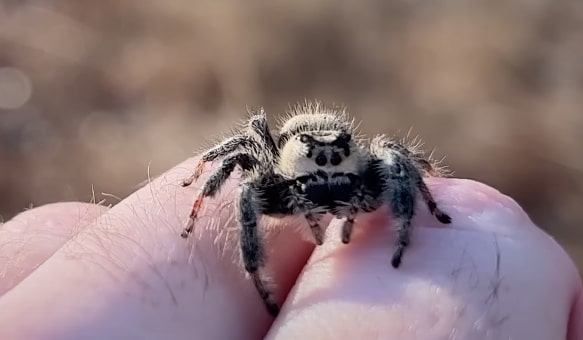Are you tired of having the same pets and want something fascinating and unique? Then how about having a spider as a pet? Imagine having a spider and watching them hunt their prey, make webs, climb, and much more. Let me suggest a fantastic regal jumping spider if you have decided to bring one home.
It also known as Phidippus regius, belong to a species of jumping spider in eastern North America and can be found in the southeastern United States.
These types of jumping spiders are kept as pets in captivity. Many people like to keep them as pets because of their unique appearance, curiosity, and active nature.
How can you recognize that Phidippus Regius is Male or Female?
The jumping spiders are sexually dysmorphic, meaning both male and female spiders have different physical characteristics, behaviors, and traits. This makes it very easy to distinguish between male and female Phidippus regius.

The first visual cues that can help you recognize male and female spiders are:
- The female spider is relatively more enormous as compared to the male spider. The female grows to 0.28 inches to 0.87 inches, whereas the male spider grows to 0.24 inches to 0.71 inches.
- The Phidippus regius have different colors; the male is black and has white spots and stripes on their bodies, whereas the female spiders have a similar pattern of shades, or vivid orange and gray.
- Three spots on the back of the abdomen of male and female spiders resemble a smiling face, giving this spider a charming look.
- Enlarged pedipalps are present appendages near the heads of male jumping spiders, which are used to transfer sperm during mating.
- During the mating seasons, male spiders are more active in attracting female spiders.
- There are fang-like structures called chelicerae near the mouth of these jumping spiders, but in males, chelicerae are more extensive than in females.
How long do Regal Jumping Spider live?

Regal spider’s lifespan depends on various factors, including spider habitats and food availability.
Lifespan of the Phidippus Regius Living in the Wild
Their lifespan is short as compared to other species. They live only 10 months in the wild for various reasons, such as predators, environmental conditions, and food availability.
Lifespan of Phidippus Regius Living in Captivity
The regal spider pet can live up to 2 years in captivity because they live in a safe environment away from predators, stable food sources, and harsh weather.
What do Regal Spiders Eat?
Phidippus Regius are carnivores, eat only three to four times a day, and rely on insects like crickets and mealworms for their food source. In the wild, these spiders also eat pests commonly found on sugarcane and citrus plants, such as flies, locusts, ants, beetles, mosquitoes, shield bugs, true bugs, aphids, etc.
They are known as skilled hunters and don’t wait for their prey to come down. Instead, they like to catch their prey with the help of their sharp eyesight.
Scientific Classification of the Jumping Spider
The scientific classification of the Phidippus Regius is mentioned below:
- Kingdom: Animalia
- Phylum: Arthropoda
- Class: Arachnida
- Order: Araneae
- Family: Salticidae
- Genus: Phidippus
- Species: Regius
Exploring the Regal Jumping Spider Habitat
The jumping spider (Phidippus regius) is commonly found in tropical regions, mainly in the southeastern United States, Florida, and the West Indies.

This is a list of places to find these cute little hairy spiders.
- Florida
- West Indies
- Texas
- Bahamas
- Alabama
- South
- Carolina georgia
- Great Antilles
- Southeastern United States
You must protect their natural habitat to keep a pet jumping spider. Pet jumping spiders mostly make their homes in the cracks in the walls.
- Phidippus Regius can be found in woodlands or fields in the herbaceous zone. The subadult spiders prefer semi-arid habitats with palmettoes and palms.
- These spiders prefer to live in warmer climates between 80°F and 86°F, as per the climate of their native southeastern North America. If you are considering getting a pet jumping spider, provide them a suitable temperature between 75°F and 82°F.
- The space they are living in should be more vertical than horizontal. They are good climbers, so the vertical enclosure will help them to climb freely and explore.
- There must be some holes in the spider enclosure to provide ventilation. Make sure to keep the holes small, or there is a chance that the spider will escape through them.
- Due to its natural habitat, Phidippus regius likes to live in warm and humid environments. You can provide them with plants and branches for webbing and climbing so they can make their space suitable.
Related Post: Zebra Spider: Habitat, Diet, Reproduction & Facts
Are Regal Jumping Spider Poisonous?
Many people like this cute-looking spider, but they need to figure out whether Phidippus regius bite or are venomous?

Phidippus regius is known for its cute looks and peaceful and non-aggressive nature. They contain venom, but it is not dangerous for humans; they only use it to catch and kill their prey. If these spiders see humans, they just go away from there. On infrequent occasions, they bite humans, and the individual will feel a little sting and slight irritation on the bite, but that will go away in a few minutes.
Some common health issues with the Regal jumping spider pet
This spider pet can also get sick and must be cared for like other pets. They are considered low-maintenance pets, but some common health issues they face in their lives are:
- Respiratory infections
- Infections that are caused by fungi, bacteria, and injuries.
- Mites and parasites can infest the spiders.
- Dehydration
- Malnutrition
- Injuries while catching their prey.
These are the few health problems they can get in their lives. Just check them daily, and you can consult a doctor if you see anything unusual.
Where can I buy a Regal jumping spider?
You can purchase Phidippus regius from the few resources below, but while buying a jumping spider, ensure they are healthy, not injured, and are obtained legally.

1. Online
There are many posts related to spider pets for sale on the websites.
There are many sellers selling spider pets online. You can visit their websites and compare their prices, as most sellers sell them at very high prices.
Choose a seller with good ratings and reviews to avoid fraud and scams.
2. Pet Shows
You can also find the sellers at Pet shows and expos selling these spiders. These pet Shows are an excellent opportunity to visit and look at different pets. You can tell the vendors you want to purchase Phidippus Regius and check carefully before purchasing.
3. Local Pet Stores
Visit the local pet store to inquire about the availability of the jumping spider or if they can arrange one.
These local pet stores are very convenient places to find any pet you want or order a specific pet.
4. Spider Breeders
Look for spider breeders; they can provide the required breed of spiders. You can find spider breeders online and ask the local pet shops about spider breeders.
What is the Regal Jumping Spider pet price?
The price of the spiders (Phidippus Regius) depends on various factors, including the spider’s sex, age, size, or the type of seller you are purchasing it from.
These spiders are inexpensive and range from $20 to $60.
Remember that you must spend money on their enclosure, food, health maintenance, and creating a suitable environment for them.
Related Article:
- Bold Jumping Spider – Your New Adorable & Exciting Pet
- Knowing Your Jumping Spider Pet: A Comprehensive Guide
Regal Jumping Spider Care Guide:
They are straightforward to take care of as they are small and adaptable. Here is the guide to help you care for your cute little pet.
- They like bright light, so provide light during the day or set an LED light on their enclosure. You can also set their enclosure in a bright space.
- Make sure to keep the temperature of their surroundings according to their habitat. They like to live in warm temperatures.
- They like to hunt their food, like flies, locusts, etc. You can still offer food to them after 3–4 days. They are carnivores, so they will not eat anything like plants or leaves, so you can give them flies, and for adult spiders, you can give them larger prey.
- Put tiny drops of water on the side of the enclosure so spiders can drink when they feel thirsty. Make sure that the water drops are not big enough because the surface tensions can be deadly for them.
- Add leaves and branches to their closure so they can feel close to their natural habitat.
- Add little holes in their enclosure for ventilation. The holes must be small, or they can escape from them.
Exploring Regal Jumping Spider:
- You can use a long plastic or coffee cup to make the enclosure. These spiders like to make their webs in the highest spot, so both can be good options. Also, choose a vertical enclosure rather than a horizontal one because these spiders like to climb to heights.
- Don’t leave the prey if it is alive inside the enclosure because if they are molting, they can get scared of their sounds, and it can be dangerous for their lives.
- If the spider is molting, do not touch them. The molding process can be long, so be patient and keep an eye on them.
- Keep their enclosure clean.
- Wash your hands before and after touching them.
Regal Jumping Spider’s Breeding
The Phidippus regius is known to breed spiders. If you will breed them, keep a few things mentioned below in mind.
- Provide an enclosure with ample space to move and climb freely with proper ventilation.
- Central temperature and humidity.
- Take care of their diet and keep them hydrated.
- During breeding, keep male and female spiders separate to prevent aggression.
- Introduce male and female spiders for breeding. When male spiders see the female spiders, they wave the pedipalps to convey their message, and the female spiders also respond.
- Then the female jumping spider will lay eggs, hatching in a few days to weeks.
- After the eggs are hatched, take care of the spiderlings properly until they are big enough to care for themselves.
Breeding spiders can be a time-consuming process that requires experience and patience. It is not recommended for those who have never done it before.
Conclusion
These cute little hairy spiders are fantastic to keep as pets. You’ll be okay with seeing them hunting, climbing, and much more.
If you are taking this spider home, remember that it is also a living thing like a cat or dog, and they should be treated like a regular pet.
Give them a proper diet, all the other things they need, and medical treatment if they need one.
FAQs
Some interesting facts about the Regal jumping spiders?
Despite being so small, they have many abilities that amaze people, and they like to keep them as pets.
Some of these abilities are:
- Their large eyes can see colors, shapes, and their prey from a distance.
- They are smart, can solve problems, and are adaptable hunters.
- They moly 6 to 9 times in their lifetime.
- They don’t like to interact with other spiders.
- They are low-maintenance pets.
Is it okay to hold a regal jumping spider?
Yes, you can hold Phidippus regius because they are non-aggressive, and under infrequent circumstances, they bite if they feel threatened, but they are harmless.
If you hold them for the first time, you should observe them and then hold them gently with care, and you’ll find them super cute and squishy.
How many times have regal jumping spider molted in their lives?
Molting is a crucial process in which insects and other creatures shed their exoskeletons and make new ones. This is an essential process for them, as it helps them to repair if anything is damaged, grow, and adapt to different environments.
Phidippus regius grows up through the fascinating process known as molting. The jumping spiders molt from six to nine times in their lifetime.




Leave a Reply